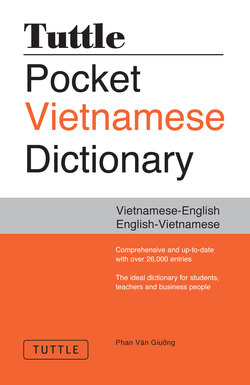Читать книгу Tuttle Pocket Vietnamese Dictionary - Phan Van Giuong - Страница 7
На сайте Литреса книга снята с продажи.
ОглавлениеA Guide to Vietnamese Pronunciation
Like Chinese and Thai, Vietnamese is a tonal language where no word is conjugated. The Vietnamese alphabet has 29 letters:
a, aê, aâ, b, c, d, ñ, e, eâ, g, h, i, k, l, m, n, o, oâ, ô, p, q, r, s, t, u, ö, v, x, y.
The Vietnamese consonants are written as single letters or a cluster of two or three letters, as follows:
b, c, ch, d, ñ, g, gh, gi, h, k, kh, l, m, n, ng, ngh, nh, p, ph, qu, r, s, t, th, tr, v, x.
The vowels in Vietnamese are the following: a, aê, aâ, e, eâ, i/y, o, oâ, ô, u, ö. Vowels can also be grouped together to form a cluster or a word.
The following charts show the vowels and consonants in Vietnamese pronunciation with their English equivalents.
Vowels
| Vietnamese | English | Example | Meaning |
| a | father | ba | three |
| aê | hat | aê | to eat |
| aâ | but | aâm | sound |
| e | bet | em | younger brother/sister |
| eâ | may | ñeâ m | night |
| i/y | me | kim | needle |
| o | law | lo | to worry |
| oâ | no | coâ | aunt |
| ô | fur | bô | butter |
| u | too | ngu | stupid |
| ö | wh-wh | thö | letter |
Consonants
| Vietnamese | English | Example | Meaning |
| b | book | buù t | pen |
| c, k, q | can | caù | fish |
| kem | ice-cream | ||
| quyù | precious | ||
| ch | chore | cho | to give |
| d, gi | zero | da | skin |
| gì | what | ||
| ñ | do | ñi | to go |
| g/gh | go | ga | railway station |
| ghe | boat | ||
| h | hat | hai | two |
| kh | (no real English equivalent) | khoâng | no |
| l | lot | laø | to do |
| m | me; him | mai | tomorrow |
| n | not; in | nam | south |
| ng/ngh | singer | ngon | delicious |
| nghe | to hear | ||
| nh | canyon | nho | grape |
| ph | phone | phaûi | right |
| r | run | ra | to go out |
| s | show | söõa | milk |
| t | top | toát | good |
| th | thin | thaêm | to visit |
| tr | entry | treân | on/ above |
| v | very | vaø | and |
| x | see | xa | far |
Tones
The standard Vietnamese language has six tones. Each tone is a meaningful and integral part of the syllable. Every syllable must have a tone. The tones are indicated in conventional Vietnamese spelling by diacritic marks placed over (aù, aø, aû, aõ) or under (aï) single vowels or the vowel in a cluster that bears the main stress (v).
| Vietnamese | Tone mark | Description | Example | Meaning |
| Khoâ ng daáu (no) | o | Voice starts at middle of normal speaking range and remains at that level | maø | ghost |
| Saé c high-rising | où | Voice starts high and rises sharply | maù | cheek |
| Huyeà n low-falling | oø | Voice starts at a fairly low and gradually falls | maø | but |
| Naë ng low-broken | oï | Voice falls, then cuts off abruptly | maï | rice seedling |
| Hoû i low-rising | oû | Voice falls initially, then rises slightly | maû | tomb |
| Ngaõ high-broken | oõ | Voice rises slightly, is cut off abruptly, then rises sharply again | maõ | horse |
Tone Symbols
The six tones just described are summarized in the following chart to illustrate the differences between them as they are associated with individual words.
The Vietnamese language has its national standard syntax, morphology and the tone system, although there are some regional variations in pronunciation and accents. The significant differences in pronunciation and accents between the Northern and Southern people (represented by Hanoi and Saigon respectively) are as follows:
1. There is no difference in the single vowels between Hanoi and Saigon.
2. There are two vowel clusters /öu/ and /öôu/ which are pronounced /iu/ and /ieâu/ by Hanoi, and /öu/ and /öôu/ by Saigon.
3. Differences in the pronunciation of consonants:
4. Saigonese do not differentiate between the two tones /?/ and /~/; these are pronounced alike.
We hope that all users of this Pocket Vietnamese Dictionary —be they Vietnamese students learning English, or English-speaking expatriates, students or business people—will find this a most up-to-date and user-friendly Vietnamese dictionary, for all aspects of daily communication.
